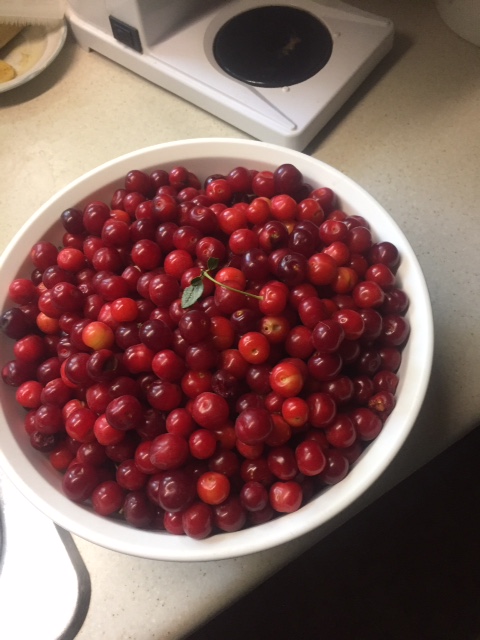Sara Williams
The dwarf sour cherries bred at the University of Saskatchewan since 1999 are dwarf but not always sour. Many can be eaten fresh right off the bush. Rather than trees, they are grown as multi-stem shrubs, 8 to 9 feet (240-275 cm) high. But they can be easily maintained at 6 to 7 feet (180-215) with regular pruning.
Bush cherries often start fruiting in their fourth or fifth year when they are about 4 feet (120 cm) tall. By the time they are 6 x 4 feet (180 x 120 cm) they are generally yielding 20 to 30 pounds (9-14 lb) of fruit. In Saskatchewan, most of these cherries fruit from the last week in July to the second week of August. The fruit can be bright red, burgundy or almost black when fully ripe.
These dwarf sour cherries are best grown as multi-stem shrubs. About 8 to 9 feet (240-275 cm) in height, their glossy green leaves, showy white flowers and bright fruit lend them ornamental as well as food value. Sour cherries are self-compatible. They do not need pollen from another variety or bush in order to set fruit.
Bush varieties released by the University of Saskatchewan include:
‘Carmine Jewel’ (1999, zone 2), the first dwarf sour cherry introduced by the University of Saskatchewan is also the first to ripen, often by the last week of July. The cherries have good flavour and aroma and are very good for processing. At 6-7 feet (180-210 cm) in height, it is a bit shorter than the other varieties. Its height, coupled with reduced suckering, make it ideal for an urban landscape.
The Romance Series:
‘Crimson Passion’ (2003, zone 3) has the highest quality fruit of the dwarf cherries, a blend of sweet and sour, good for fresh eating. It is the smallest (4-5 feet / 120-150 cm), rarely suckers and grows slowly, an excellent choice for smaller spaces.
‘Cupid’ (2003, zone 2 and perhaps colder) has black fruit on 7-8 feet (210-240 cm) bushes that ripen in early August. It blooms later, generally avoiding damaging late frosts. It has the largest fruit size (6.5 g) but its pits are often too large for hand-held pitters. Although its fruit yields are about half that of other varieties, its flavour is especially tangy and it’s excellent for dipping in chocolate or canning whole.
‘Juliet’ (2003, zone 2 and perhaps colder) has burgundy-red fruit averaging 5 g and excellent fresh flavour. It is 7-8 feet (210-240 cm) with a strong spreading form. It tends to bloom a few days earlier than other varieties and goes dormant a week or so earlier.
‘Romeo’ (2003, zone 3 and warmer) is considered the best of the cherries for fresh eating. It comes into production a year before other varieties, but has a tendency to over-produce which sometimes means lower yields in off years. The dark burgundy fruit average 4 g and ripen in early August. The plants are very similar to those of ‘Carmine Jewel.’
‘Valentine’ (2003, zone 2, worth trying in 1a) is the only dwarf cherry with bright red fruit, keeping its colour when dried while other varieties become almost black. The fruit weighs 4.5 g. It is the largest shrub of the dwarf sour cherries.
Planting and care:
Sour cherries do best in weed-free, well drained soils in full sun. They do not like “wet feet.” As individual plants, space the dwarf sour cherries about 5 feet (150 cm) apart. If a hedge if preferred, plant them 3 feet (90 cm) apart. To conserve moisture and control weeds, mulch them after planting with 4 inches (10 cm) of post peelings, wood chips, clean (weed-free) straw or leaves.
Apply a granular fertilizer such as 11-48-0, 16-20-0 or 11-48-0 just beyond their drip line in early spring before growth begins. Beware! Too much nitrogen encourages growth into late fall which may then not harden off in time for winter, creates leafy growth at the expense of fruit, and results in more succulent tissue that is vulnerable to disease and insect entry.
Pruning:
Dwarf sour cherries are shrubs, not trees. Once established, prune them in early spring before growth begins. Branches 7 years or older have reached the end of their productive years and should be removed. Begin pruning at the base, as close to soil level as possible. Remove about 25% of the oldest, thickest branches. By “opening up” the interior to sunlight and air movement, insect and disease habitat is reduced, while flower production is increased. This results in a higher yield of larger, tastier and better quality fruit.
Avoid simply “shearing” the shrub’s exterior. If sheared, the plant responds by developing multiple new stems at every cut, in effect, creating a “hedge” at the end of every sheared branch. Instead of increasing sunlight and air penetration to the interior, you will have further blocked it.
The biggest problem you’re likely to encounter with cherries is the cherry fruit fly. Naturalyte, a spinosad formulation, is registered for use by home gardeners.
This column is provided courtesy of the Saskatchewan Perennial Society (SPS; saskperennial@hotmail.com). Check our website (www.saskperennial.ca) or Facebook page (www.facebook.com/saskperennial) for a list of upcoming gardening events.

